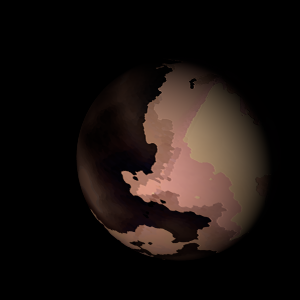| Fictional info (?) |
|---|
| Suggested name | Gyobyu Kyo |
| Planet type | Cold planet |
| When viewed from Earth, this proximity to Kepler-1311 means the planet can only be seen near the western or eastern horizon during the early evening or early morning.
As seen relative to the fixed stars, it rotates on its axis exactly three times for every four revolutions it makes around Kepler-1311.
The polar regions are constantly below 225°K (-48°C).
This unpleasant planet is mostly dangerous because of the unreliable primordial oceanic creatures, the "Sohijupya", that feed hidden in craters while finding nourishment in smaller pray if they can. They are similar to the Sado but have scales and vary in size from 3 to 7 cm. They are known to withstand temperatures from 90 to 170°C but are killed by electrical shock which is common on this planet. |
| Estimated population | 1000000 |
| Atmosphere | Carbon dioxide | 62% |
| Water | 37% |
| Methane | 0.33% |
| Oxygen | 0.054% |
| Atmospheric pressure | 30 bar |
 |
| Moon | Kyote'sonya | Small round crater-filled moon |
| Hyagina Tsu | Medium-sized round ice moon |
| Choshi-gya | Large slightly egg-shaped crater-filled moon |
| Guyapu Hyuryo | Very small round rocky asteroid |
| Hyohyo Tomegyo-cha | Medium-sized potato shaped ice moon |
| Mupya-chapyu'hyu | Huge slightly egg-shaped ice asteroid |
| Hanyozo Po | Very small round gaseous moon |
| Homyo-tawapo No | Small round oceanic moon |
| Gojo | Medium-sized potato shaped gaseous moon |
| Nnehyu Boro-naku | Very small potato shaped gaseous asteroid |
| Rakyo-hya | Medium-sized almost round rocky asteroid |
| Nyajagi | Medium-sized round gaseous moon |
| Pohyuzo Bane | Very small slightly egg-shaped oceanic comet |
| Sarya Mupi-pabe | Huge slightly egg-shaped rocky asteroid |
| Shoseyo | Very small slightly egg-shaped oceanic moon |
| Pamya Kyo | Very small slightly egg-shaped rocky moon |
| Sori Pyu | Medium-sized irregular oceanic planetoid |
| Myodo Kyase | Very small almost round rocky asteroid |
| Churubyu-no | Large potato shaped rocky moon |
| Kozore-gebo | Very small irregular gaseous asteroid |
| Gehasa | Huge round crater-filled planetoid |
| Yuju | Small slightly egg-shaped crater-filled moon |
| Funa Muta Bukyu | Large irregular ice planetoid |
| Mepyo | Very small round gaseous moon |
| Boashoho Kyupya | Medium-sized almost round gaseous moon |
| Wowo Sa | Huge almost round ice moon |
| Mozepya Zu | Small potato shaped crater-filled moon |
| Google search for Gyobyu kyo |